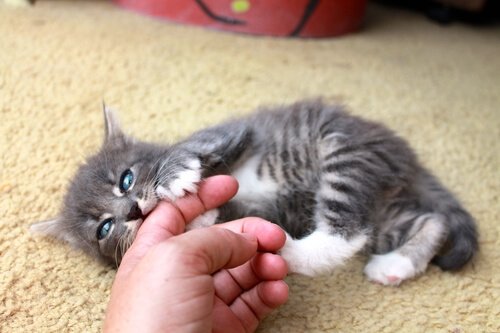When we think of cats, we think of docile animals that have earned a reputation for staying calm in certain situations. However, there are some things that can bother them or provoke an aggressive reaction. In today’s article, we’ll tell you about the different signs that show your cat is angry.
Main reasons for cat’s anger
Generally, when your cat is angry it’s because he’s afraid of a specific situation that he doesn’t think he can escape from. Because of that, he thinks his only option is to attack so that he can defend himself.
An angry cat will display some signs to show what he’s feeling. That’s why it’s important to know how to interpret his body language. This will help you avoid any difficult situations for you, other people, other pets and, of course, your own cat.
There are a few main causes of fear that can trigger aggressive behavior in cats, especially if they’re not properly socialized. These can include strange people and animals, loud noises, and strange places. However, you won’t always be able to easily identify what’s bothering them. Be patient.
If your cat gets angry, he may have an aggressive reaction, especially if he’s afraid. That’s why it’s important to know the signs that show that your cat is angry or afraid.
Signs that your cat is angry
These are some of the signs that your cat is angry, scared or might attack:
- Arching his back
- His fur is sticking up
- Meowing loudly and hissing
These are innate ways of behaving, and he does them to make himself seem bigger in order to intimidate his possible attacker. You should also keep in mind that a cat can change his mood from calm to angry or scared in a matter of seconds.
Other signs that your cat is irritated
Another sign that you should pay attention to is when your cat starts to move his tail very quickly. Unlike with dogs, this actually means that he’s irritated.
Also, make sure you’re paying attention to his gestures. If his pupils are dilated, his whiskers facing forwards and his ears low and pointing backward, you can be almost certain that he’s about to attack.
This is especially true if he doesn’t think he can escape the situation. Additionally, if he opens his mouth to show his teeth, you should get away from him fast so that he won’t bite or scratch you.
The best thing to do in these situations is to leave the animal alone for a while to let him calm down. If these situations continue, you should talk to your vet.
Some facts about anger and fear in domestic cats
Also, keep the following information in mind about our purring friends:

- If a new pet in the house is causing your cat’s fearful or aggressive behavior, be aware that you should introduce them to each other gradually.
- Never leave a child alone with a cat. The child may do something, like pulling his tail, that will cause the animal to react badly.
- If your cat is sick or sore, he may also act aggressively.
- Cats that have suffered abuse are often afraid and aggressive.
- As they get older, felines—just like humans—lose their patience and become more irritable than usual.
How to act around an angry and fearful cat
You certainly shouldn’t try to pet your cat or lift him up if he’s showing signs of fear or anger. He’ll probably try to attack you. Respect him by giving him the time he needs to calm down.
Ideally, the kitten should have his own space in the house where he feels safe. That way, he can go there anytime he feels intimidated by a situation.
Most importantly, don’t pressure or scold your pet when he’s irritated or afraid. Let him get over the bad situation and then try to avoid those situations in the future. Depending on the case, you can patiently help him face the situations that scare him or that make him angry.

No comments:
Post a Comment